International Journal of Image, Graphics and Signal Processing @ijigsp
Статьи журнала - International Journal of Image, Graphics and Signal Processing
Все статьи: 1157
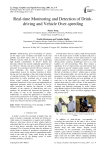
Real-time monitoring and detection of drink-driving and vehicle over-speeding
Статья научная
Drink-driving and over-speeding of vehicles are the major causes of injuries and deaths on the road globally and South Africa (SA) is not an exception. Different systems which are currently used in detecting high alcohol concentration in drivers’ breath and detecting vehicles that exceeds stipulated speed limit are not effective, efficient and poses health risks to traffic personnel. In an attempt to provide effective solutions to these challenges, this paper proposed a smart transportation system for real-time detection of drink-driving and over-speeding on the roads using technology of vehicular networks. The objective is to allow for early intervention by traffic personnel aim at saving lives before actual accident occurred. We designed a theoretical framework of the system and implemented an application prototype which is web-based for use by traffic personnel to monitor the detection of traffic offenders in the capacity of drink-driving and over-speeding. We presented and discussed the operation of the system as well as the functionalities it offers. Additionally, we utilized the application to simulate the actual system and based on its working, we found that the system is feasible and can accomplish the tasks of road safety more effective than the existing approaches.
Бесплатно
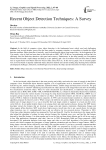
Recent Object Detection Techniques: A Survey
Статья научная
In the field of computer vision, object detection is the fundamental most widely used and challenging problem. Last several decades, great effort has been made by computer scientists or researchers to handle the object detection problem. Object detection is basically, used for detecting the object from image/video. At the beginning of the 21st century, a lot of work has been done in this field such as HOG, SIFT, SURF etc. are performing well but can’t be efficiently used for Real-time detection with speed and accuracy. Furthermore, in the deep learning era Convolution Neural Network made a rapid change and leads to a new pathway and a lot of excellent work has been done till dated such as region-based convolution network YOLO, SSD, retina NET etc. In this survey paper, lots of research papers were reviewed based on popular traditional object detection methods and current trending deep learning-based methods and displayed challenges, limitations, methodologies used to detect the object and also directions for future research.
Бесплатно
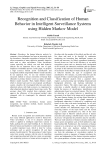
Статья научная
Nowadays, the human behavior analysis by computer vision techniques has been an interesting issue for researchers. Automatic recognition of actions in video allows automation of many otherwise manually intensive tasks such as video surveillance. Video surveillance system especially for elderly care and their behavior analysis has an important role to take care of aged, impatient or bedridden persons. In this paper, we propose a high accuracy human action classification and recognition method using hidden Markov model classifier. In our approach, first, we use star skeleton feature extraction method to extract extremities of human body silhouette to produce feature vectors as inputs of hidden Markov model classifier. Then, hidden Markov model, which is learned and used in our proposed surveillance system, classifies the investigated behaviors and detects abnormal actions with high accuracy in comparison by other abnormal detection reported in previous works. The accuracy about 94% resulted from confusion matrix approve the efficiency of the proposed method when compared with its counterparts for abnormal action detection.
Бесплатно

Recognition of Double Sided Amharic Braille Documents
Статья научная
Amharic Braille image recognition into a print text is not an easy task because Amharic language has large number of characters requiring corresponding representations in the Braille system. In this paper, we propose a system for recognition of double sided Amharic Braille documents which needs identification of recto, verso and overlapping dots. We used direction field tensor for preprocessing and segmentation of dots from the background. Gradient field is used to identify a dot as recto or verso dots. Overlapping dots are identified using Braille dot attributes (centroid and area). After identification, the dots are grouped into recto and verso pages. Then, we design Braille cell encoding and Braille code translation algorithms to encode dots into a Braille code and Braille codes into a print text, respectively. With the purpose of using the same Braille cell encoding and Braille code translation algorithm, recto page is mirrored about a vertical symmetric line. Moreover, we use the concept of reflection to reverse wrongly scanned Braille documents automatically. The performance of the system is evaluated and we achieve an average dot identification accuracy of 99.3% and translation accuracy of 95.6%.
Бесплатно
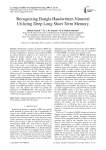
Recognizing Bangla handwritten numeral utilizing deep long short term memory
Статья научная
Handwritten numeral recognition (HNR) has gained much attention in present days as it can be applied in range of applications. Research on unconstrained HNR has shown impressive progress in few scripts but is far behind for Bangla although it is one of the major languages. Bangla contains similar shaped numerals which are difficult to distinguish even in printed form and this makes Bangla HNR (BHNR) a challenging task. Our goal in this study is to build up a superior BHNR framework and consequently explore the profound design of Long Short Term Memory (LSTM) method. LSTM is a variation of Recurrent Neural Network and is effectively used for sequence ordering with its distinct features. This study considered deep architecture of LSTM for better performance. The proposed BHNR with deep LSTM (BNHR-DLSTM) standardizes the composed numeral images first and then utilizes two layers of LSTM to characterize singular numerals. Benchmark dataset with 22000 handwritten numerals having various shapes, sizes and varieties are utilized to examine the proficiency of BNHR-DLSTM. The proposed method indicates agreeable recognition precision and beat other conspicuous existing methods.
Бесплатно
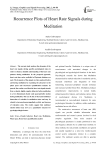
Recurrence Plots of Heart Rate Signals during Meditation
Статья научная
The current study analyses the dynamics of the heart rate signals during specific psychological states in order to obtain a detailed understanding of the heart rate patterns during meditation. In the proposed approach, heart rate time series available in Physionet database are used. The dynamics of the signals are then analyzed before and during meditation by examining the attractors in the phase space and recurrence quantification analysis. In general, the results reveal that the heart rate signals transit from a chaotic, highly-complex behavior before meditation to a low dimensional chaotic (and quasi-periodic) motion during meditation. This can be due to decreased nonlinear interaction of variables in meditation states and may be related to increased parasympathetic activity and increase of relaxation state. The results suggest that nonlinear chaotic indices may serve as a quantitative measure for psychophysiological states.
Бесплатно
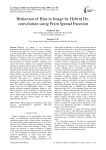
Reduction of Blur in Image by Hybrid De-convolution using Point Spread Function
Статья научная
Blurring of images is an unwelcome phenomenon that is difficult to avoid in many situations. It degrades the quality of a variety of images, including real life photographic images, astronomical images and medical images. In this paper a new image de-blurring algorithm is proposed using Lucy Richardson method. De-blurring is performed in two stages. To arrive at the best guestimate, an iterative method is employed as an initial step which computes the maximum likelihood estimate of the point spread function (PSF) without any prior information. In the second step, Lucy Richardson algorithm takes the PSF estimated in the initial step as its input parameter. In particular, for better processing of the image, suitable color space identification is done as a pre-processing step. This makes use of the idea of edge detectors. This paper, as a significant contribution, proposes a de-blurring technique, which uses a hybrid de-convolution method with a color space identification stage. This enables its application for a broad spectrum of images from real life photographic images to single photon emission computed tomography images as well. The performance of the algorithm is compared against other existing de-blurring algorithms and the results prove a better output in terms of blur reduction. Standard test images and real medical images are used for appraising the algorithm.
Бесплатно
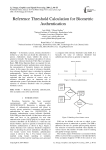
Reference Threshold Calculation for Biometric Authentication
Статья научная
In biometric systems, reference threshold is defined as a value that can decide the authenticity of a person. Authenticity means whether the person is genuine or intruder. The statistical calculation of various values like reference threshold, FAR (False Acceptance Rate), FRR (False Rejection Rate) are required for real-time automated biometric authentication system because the measurement of biometric features are statistical values. In this paper, the need of reference threshold, how reference threshold value is calculated is explained mathematically. Various factors on which reference threshold value depends are discussed. It is also explained that how selection of correct value of reference threshold plays an important role in authentication system. Experimental results describe the selection of reference threshold value for palmprint biometric system.
Бесплатно
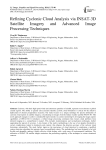
Статья научная
Cyclones, with their high-speed winds and enormous quantities of rainfall, represent severe threats to global coastal regions. The ability to quickly and accurately identify cyclonic cloud formations is critical for the effective deployment of disaster preparedness measures. Our study focuses on a unique technique for precise delineation of cyclonic cloud regions in satellite imagery, concentrating on images from the Indian weather satellite INSAT-3D. This novel approach manages to achieve considerable improvements in cyclone monitoring by leveraging the image capture capabilities of INSAT-3D. It introduces a refined image processing continuum that extracts cloud attributes from infrared imaging in a comprehensive manner. This includes transformations and normalization techniques, further augmenting the pursuit of accuracy. A key feature of the study's methodology is the use of an adaptive threshold to correct complications related to luminosity and contrast; this enhances the detection accuracy of the cyclonic cloud formations substantially. The study further improves the preciseness of cloud detection by employing a modified contour detection algorithm that operates based on predefined criteria. The methodology has been designed to be both flexible and adaptable, making it highly effective while dealing with a wide array of environmental conditions. The utilization of INSAT-3D satellite images maximizes the performing capability of the technique in various situational contexts.
Бесплатно
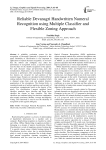
Статья научная
A reliability evaluation system for the recognition of Devanagri Numerals is proposed in this paper. Reliability of classification is very important in applications of optical character recognition. As we know that the outliers and ambiguity may affect the performance of recognition system, a rejection measure must be there for the reliable recognition of the pattern. For each character image pre-processing steps like normalization, binarization, noise removal and boundary extraction is performed. After calculating the bounding box features are extracted for each partition of the numeral image. Features are calculated on three different zoning methods. Directional feature is considered which is obtained using chain code and gradient direction quantization of the orientations. The Zoning firstly, is considered made up of uniform partitions and secondly of non-uniform compartments based on the density of the pixels. For classification 1-nearest neighbor based classifier, quadratic bayes classifier and linear bayes classifier are chosen as base classifier. The base classifiers are combined using four decision combination rules namely maximum, Median, Average and Majority Voting. The framework is used to test the reliability of recognition system against ambiguity.
Бесплатно
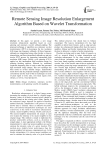
Remote Sensing Image Resolution Enlargement Algorithm Based on Wavelet Transformation
Статья научная
In this paper, we present a new image resolution enhancement algorithm based on cycle spinning and stationary wavelet subband padding. The proposed technique or algorithm uses stationary wavelet transformation (SWT) to decompose the low resolution (LR) image into frequency subbands. All these frequency subbands are interpolated using either bicubic or lanczos interpolation, and these interpolated subbands are put into inverse SWT process for generating intermediate high resolution (HR) image. Finally, cycle spinning (CS) is applied on this intermediate high resolution image for reducing blocking artifacts, followed by, traditional Laplacian sharpening filter is used to make the generated high resolution image sharper. This new technique has been tested on several satellite images. Experimental result shows that the proposed technique outperforms the conventional and the state-of-the-art techniques in terms of peak signal to noise ratio, root mean square error, entropy, as well as, visual perspective.
Бесплатно
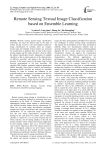
Remote Sensing Textual Image Classification based on Ensemble Learning
Статья научная
Remote sensing textual image classification technology has been the hottest topic in the filed of remote sensing. Texture is the most helpful symbol for image classification. In common, there are complex terrain types and multiple texture features are extracted for classification, in addition; there is noise in the remote sensing images and the single classifier is hard to obtain the optimal classification results. Integration of multiple classifiers is able to make good use of the characteristics of different classifiers and improve the classification accuracy in the largest extent. In the paper, based on the diversity measurement of the base classifiers, J48 classifier, IBk classifier, sequential minimal optimization (SMO) classifier, Naive Bayes classifier and multilayer perceptron (MLP) classifier are selected for ensemble learning. In order to evaluate the influence of our proposed method, our approach is compared with the five base classifiers through calculating the average classification accuracy. Experiments on five UCI data sets and remote sensing image data sets are performed to testify the effectiveness of the proposed method.
Бесплатно
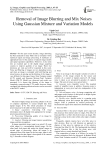
Removal of image blurring and mix noises using gaussian mixture and variation models
Статья научная
For the past recent decades, image denoising has been analyzed in many fields such as computer vision, statistical signal and image processing. It facilitates an appropriate base for the analysis of natural image models and signal separation algorithms. Moreover, it also turns into an essential part to the digital image acquiring systems to improve qualities of an image. These two directions are vital and will be examined in this work. Noise and Blurring of images are two degrading factors and when an image is corrupted with both blurring and mixed noises, de-noising and de-blurring of the image is very difficult. In this paper, Gauss-Total Variation model (G-TV model) and Gaussian Mixture-Total Variation Model (GM-TV Model) are discussed and results are presented. It is shown that blurring of the image is completely removed using G-TV model; however, image corrupted with blurring and mixed noise can be recovered with GM-TV model.
Бесплатно
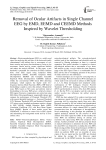
Статья научная
Electroencephalogram (EEG) is a widely used signal for analyzing the activities of the brain and usually contaminated with artifacts due to movements of eye, heart, muscles and power line interference. Owing to eye movement, Ocular Activity creates significant artifacts and makes the analysis difficult. In this paper, a new threshold is presented for correction of Ocular Artifacts (OA) from EEG signal using Empirical Mode Decomposition (EMD), Ensemble Empirical Mode Decomposition (EEMD) and Complete Ensemble Empirical Mode Decomposition (CEEMD) methods. Unlike the conventional EMD based EEG denoising techniques, which neglects the higher order low-frequency Intrinsic Mode Functions (IMFs), IMF Interval thresholding is opted to correct the artifacts. Obtained the noisy IMFs based on MI scores and perform interval thresholding to the noisy IMFs gives a relatively cleaner EEG signal. Extensive computations are carried out using EEG Motor Movement/Imagery (eegmmidb) dataset and compare the performance of Proposed Threshold (PT) with current threshold functions i.e., Universal Threshold (UT), Minimax Threshold (MT) and Statistical Threshold (ST) using several standard performance metrics: change in SNR (ΔSNR), Artifact Rejection Ratio (ARR), Correlation Coefficient (CC), and Root Mean Square Error (RMSE). Results of these studies reveal that CEEMD+PT is efficient to correct OAs in EEG signals and maintaining the background neural activity in non-artifact zones.
Бесплатно
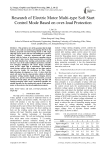
Research of Electric Motor Multi-type Soft Start Control Mode Based on over-load Protection
Статья научная
This article in view of the question that the high power motor could not starting and stopping directly in the industry, proposed one kind of design based on PIC single chip high power motor soft start and intelligence protective devices, utilized real-time measurement and control method with the feature of synchronous sampling electric current spurt value inverse time lag protection, according to the load situation four starting and protection control soft start ways of the under intelligent protection controller were designed. Intelligent soft starter design principles based on PIC single chip is articulated. The hardware circuit design, software flow design and test data analysis are given in details. By producing in Zibo Galaxy high-technology development co., Ltd.,it shows that this smart soft starter has the characteristics which are flexible parameter setting, intuitive liquid crystal display, diverse starting way, precise current limiting protection, accurate protection of lack phase, low-cost, collecting soft start and running protection with a body's protection controller, are suitable specially for the starting and control of high power motor, so the protector has broad application prospects.
Бесплатно

Research on Fuzzy Enhancement in the Diagnosis of Liver Tumor from B-mode Ultrasound Images
Статья научная
Fuzzy enhancement is applied in computer aided diagnosis of liver cancer from B mode ultrasound images as a pre-processing procedure in this paper. It was evaluated with three classifiers including K means, back propagation neural network and support vector machine using 25 features from first order statistic (FOS), gray-level co-occurrence matrix (GLCM), gray-level run-length matrix (GLRLM), Grey level dependant matrix (GLDM) and LAWS. In the analysis of 166 normal liver tissue, 30 hemangioma and 60 malignant tumor, our method improved the classification accuracy of three classifiers (K means, BP neural network and support machine vector) in distinguishing liver cancer, hemangioma and normal liver cancer from B mode ultrasound images. It is proved that fuzzy enhancement as an efficient preprocessing procedure could be used in the computer aided diagnosis system of liver cancer.
Бесплатно
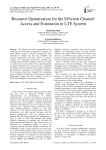
Resource Optimization for the Efficient Channel Access and Estimation in LTE System
Статья научная
LTE Standard has been an inseparable part of 3GPP that was started with an objective to upgrade 3G based Mobile Systems to 4G.This standard has been developed to enhance the data rate, reliability and seamless connectivity to the users. There is a need to evaluate the achievable performance through this standard in terms of MAC parameters. Moreover, in order to optimize the resources like Power and Bandwidth, Extensive Simulations have been done here considering the Medium Access techniques like Channel estimation, Retransmission techniques and Scheduling techniques. Two Scenarios have been designed by considering diverse Conditions of Physical Layer Resources. Optimal Performance bounds have been obtained in terms of BLER and throughput for the proposed Scenarios.
Бесплатно
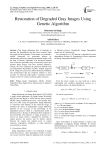
Restoration of Degraded Gray Images Using Genetic Algorithm
Статья научная
This Image deblurring aims to eliminate or decrease the degradations that has been occurred while the image has been obtained. In this paper, we proposed a unified framework for restoration process by enhancement and more quantified deblurred images with the help of Genetic Algorithm. The developed method uses an iterative procedure using evolutionary criteria and produce better images with most restored frequency-content. We have compared the proposed methods with Lucy-Richardson Restoration method, method proposed by W. Dong [34] and Inverse Filter Restoration Method; and demonstrated that the proposed method is more accurate by achieving high quality visualized restored images in terms of various statistical quality measures.
Бесплатно
Retinal Blood Vessel Segmentation with Optic Disc Pixels Exclusion
Статья научная
The morphological changes of retinal blood vessels are important indicators used to diagnose and monitor the progression of various diseases. A number of retinal blood vessel segmentation methods have been introduced, including the line operator based methods, which have shown satisfactory results. However, the basic line operator method cannot discriminate the pixels around the retinal optic disc, resulting in false classification of those pixels. In this paper, we integrate the detection of pixels around the retinal optic disc to the line operator method so that those pixels can be excluded from the vessel pixels. The method is evaluated on the widely used retinal dataset, the DRIVE dataset. The results demonstrate that the proposed method has made improvements over the basic and the multi-scale line detector with accuracy and area under curve of 0.942 and 0.9521, respectively.
Бесплатно
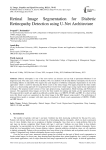
Retinal Image Segmentation for Diabetic Retinopathy Detection using U-Net Architecture
Статья научная
Diabetic retinopathy is one of the most serious eye diseases and can lead to permanent blindness if not diagnosed early. The main cause of this is diabetes. Not every diabetic will develop diabetic retinopathy, but the risk of developing diabetes is undeniable. This requires the early diagnosis of Diabetic retinopathy. Segmentation is one of the approaches which is useful for detecting the blood vessels in the retinal image. This paper proposed the three models based on a deep learning approach for recognizing blood vessels from retinal images using region-based segmentation techniques. The proposed model consists of four steps preprocessing, Augmentation, Model training, and Performance measure. The augmented retinal images are fed to the three models for training and finally, get the segmented image. The proposed three models are applied on publically available data set of DRIVE, STARE, and HRF. It is observed that more thin blood vessels are segmented on the retinal image in the HRF dataset using model-3. The performance of proposed three models is compare with other state-of-art-methods of blood vessels segmentation of DRIVE, STARE, and HRF datasets.
Бесплатно

